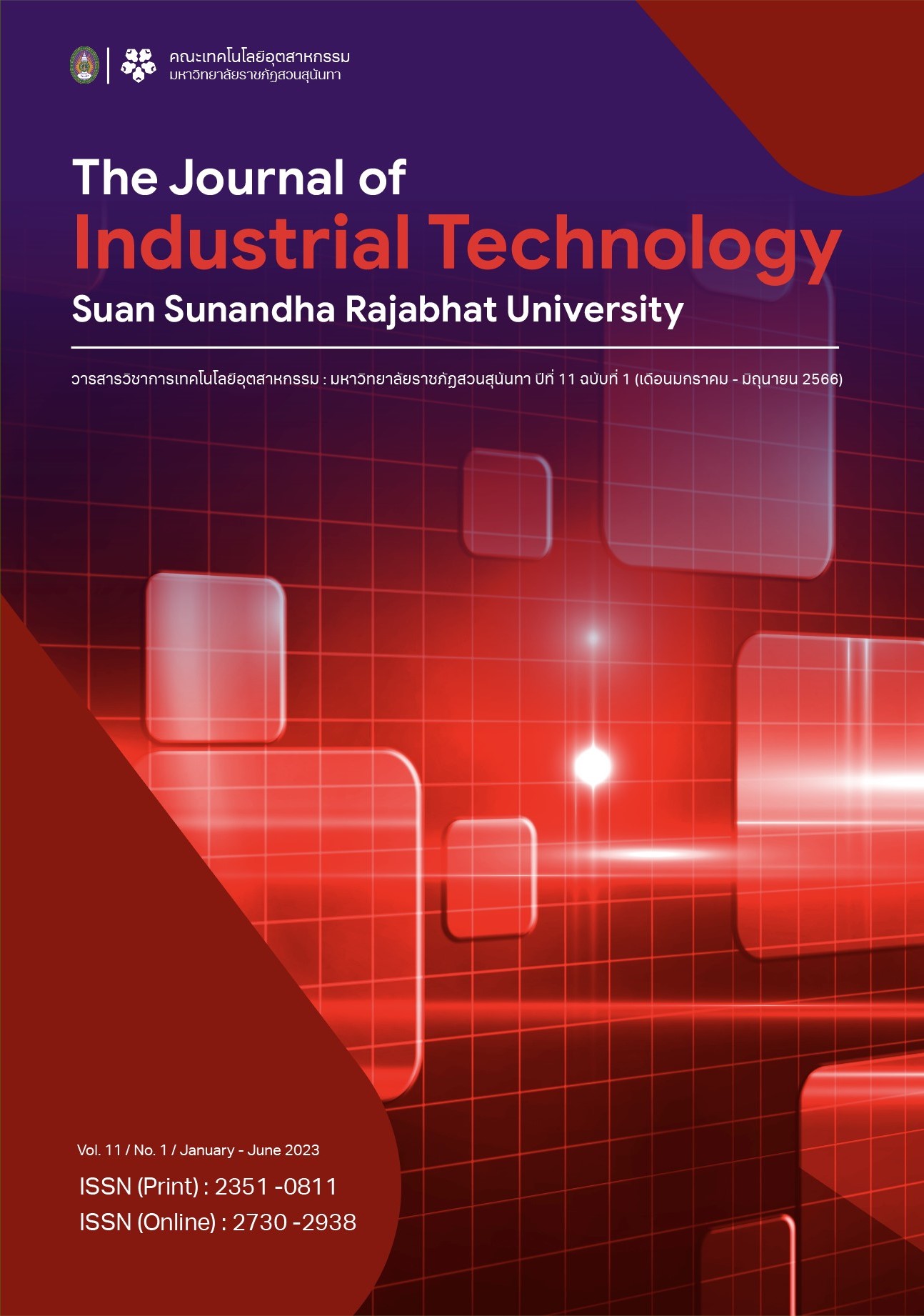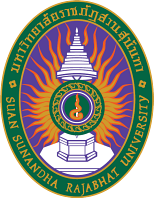Analysis of the Mechanical Properties of Polypropylene Biocomposites with Sugarcane and Wild Sugarcane reinforced Materials
Keywords:
Biocomposite, Mechanical properties, Reinforcement material, PolypropyleneAbstract
This research proposed analyses the mechanical properties of polypropylene biocomposites reinforced with sugarcane and wild sugarcane and studies the properties of conventional plastic filaments and plastic filaments containing natural fibers at a percentage ratio of 0 – 25; This adds value to plastic waste and reduces plastic waste that causes environmental problems from the garbage. The method of conducting the research starts from step 1. It uses polypropylene plastic from used plastic bottle caps to be cleaned and crushed in granular form. 2. Determine the amount of sugarcane fiber mixture and the ratio of 5, 10, 15, 20, and 25 percent by weight, respectively. 3. The next step uses a plastic syringe to make a sample of the test specimen. 4. The specimen will be subjected to mechanical testing by tensile strength. The results of tensile and elongation tests between polypropylene biocomposites reinforced with sugarcane fibers and wild sugarcane. In the case of using sugarcane as a reinforcement, it was found that the maximum force of 20% was 3,706.03 Newtons and that the sugarcane ratio of 25% had a maximum stretch of 19.75 mm. When using the wild sugarcane as a reinforcing material, it was found that at a ratio of 25%, the maximum force was 3,684.56 Newtons, and the maximum stretch was 13.84 mm. It is possible to use biocomposite materials in industry. Because it is convenient to recycle, It can also be applied to injection molding and improve the mechanical properties of bio-composites for strength.
References
U. Environment, “Plastic pollution,” UNEP, [Online].Available from : https://www.unep.org/plastic-pollution (accessed May 30, 2023).
“The role of safety for transport in APEC post covid-19”, [Online].Available from : https://apec2022.prd.go.th/the-role-of-safety-for-transport-in-apec-post-covid-19/ (accessed May 15, 2023).
“The 29th APEC Economic Leaders' Meeting during 18 - 19 November 2022 at Queen Sirikit National Convention Center, Bangkok.,” APEC, [Online]. Available from:https://www.apec2022.go. th/th/apec-economic-leaders-meeting-aelw-th/ (accessed May 15, 2023).
“What is BCG Economy Model,” NSTDA, [Online]. Available from: https://www.nstda. or.th/home/knowledge_post/what-is-bcg -economy-model/ (accessed May 30, 2023).
A. S. Aparchit Sharma, “Review of effects of fiber content and fiber length on the mechanical properties of biocomposites,” International Journal of Mechanical and Production Engineering Research and Development, vol.10, no.3, pp. 12523–12532, 2020. doi:10.24247/ijmperdjun20201192
M. Mittal and R. Chaudhary, “Effect of fiber length and content on the mechanical properties of pineapple leaf fiber reinforced- epoxy composites,” Advances in Science and Technology, 2021. doi:10.4028/www. scientific.net/ast.106.68
S. Novisa, B. B. Nugroho, H. Budiastuti, and R. Manfaati, “Characterization and production of biodegradable plastics from cassava rubber starch and old newsprint using glycerol plasticizer,” Proceedings of the International Seminar of Science and Applied Technology (ISSAT 2020), 2020. doi:10.2991/aer.k.201221.005
R. Saengsap et al. “Mechanical properties. and property of letting gas through polyethylene film mixed bagasse”. Faculty of Engineering. Khon Kaen University University Thesis. 2014.
F. Bellejoyes, “Freedom, Polypropylene, PP”, October 2012, [Online]. Available from: http://arceehechanfreedom.blogspot.com/2012/10/ (accessed May 15, 2023).
“Plastic,” POLYMER,. [Online]. Available from: https://enchemcom1po.wordpress. com/plastic (accessed May 15, 2023).
J. Zhou, Z. Sun, and D. Retraint, “Elastic and elastic-plastic stress release due to material removal in measurement of in-depth residual stresses,” International Journal of Pressure Vessels and Piping, vol.191, p. 104380, 2021. doi:10.1016/ j.ijpvp.2021.104380
S. J. Bispo, R. C. Freire Júnior, and E. M. Aquino, “Mechanical properties analysis of polypropylene biocomposites reinforced with Curaua fiber,” Materials Research, vol.18, no.4, pp. 833–837, 2015. doi:10.1590/1516-1439.022815
C. Marsh, “Test Method for Tensile Properties of Plastics”. Astm, 1990.
Downloads
Published
How to Cite
Issue
Section
License
Copyright (c) 2023 Faculty of Industrial Technology, Suan Sunandha Rajabhat University

This work is licensed under a Creative Commons Attribution-NonCommercial-NoDerivatives 4.0 International License.
บทความที่ได้รับการตีพิมพ์เป็นลิขสิทธิ์ของคณะเทคโนโลยีอุตสาหกรรม มหาวิทยาลัยราชภัฎสวนสุนันทา
ข้อความที่ปรากฏในบทความแต่ละเรื่องในวารสารวิชาการเล่มนี้เป็นความคิดเห็นส่วนตัวของผู้เขียนแต่ละท่านไม่เกี่ยวข้องกับมหาวิทยาลัยราชภัฎสวนสุนันทา และคณาจารย์ท่านอื่นๆในมหาวิทยาลัยฯ แต่อย่างใด ความรับผิดชอบองค์ประกอบทั้งหมดของบทความแต่ละเรื่องเป็นของผู้เขียนแต่ละท่าน หากมีความผิดพลาดใดๆ ผู้เขียนแต่ละท่านจะรับผิดชอบบทความของตนเองแต่ผู้เดียว








